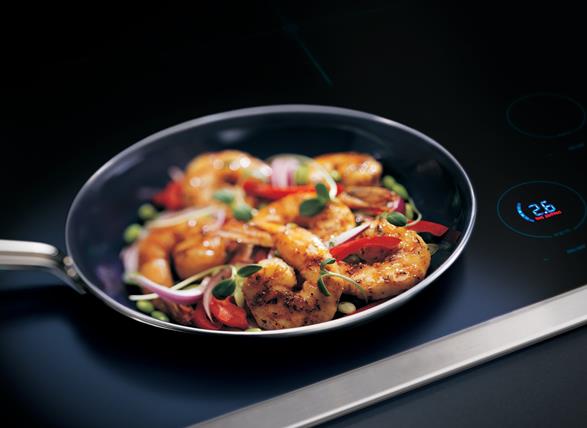Unlike traditional gas-powered stoves, cooking with induction utlizes electromagnetic waves to heat up pots and pans. Indiuction cooking occurs when electromagnetic field comes into contact with a ferromagnetic material, Non-ferrous materials such as ceramic, glass, aluminium and copper would not work on induction cooktops.
However, it would be more precise to say that the base of the cookware only needs to have iron in it in order to work. For instance, most cookware that are labeled as induction-friendly would feature a visibly thicker layer of metal at the bottom.
But if you're still not too sure whether your cookware will work with induction cooktops, you can try sticking a magnet to your cookware. If it attracts, it should work and vice versa. Additionally, the cookware also has to be flat-bottomed in order to work with induction stovetops.
Now that you know the basics of induction cooking, here are some benefits of induction cooking.
Efficiency
Cooking with induction means that the bottom of the cookware is in closer proximity to the stove compared to other cooking methods. With induction, the entire bottom of the pan is heated up, so there is no need to fit the pan to the burner.
When compared to gas and electric cooktops, induction cooktops are more energy effiicient. It is about 60% more efficient than a gas cooktop where the flame heats the area around the pan rather than directly on the base of the cookware. On the other hand, it is 40% more efficient than an electric cooktop.
Safety
It is easy to see how induction cooking is safer than conventional stovetop cooking methods. Being electrically powered, it avoids the risk that comes with open flames on stovetops as we know it.
Additionally, most induction cooktops feature safety enhancements, thus reducing kitchen fire hazards. Some of the safety features include current error detection and excess heat protection. Where the former helps regulate the current that operates the appliance, the latter ensures that the cooktop never gets too hot and is safe enough for the young ones to touch without getting burned.
Speed
Induction cooktops heat more quickly compared to gas and electric types. For comparison, a 12,000-BTU gas burner takes 36 minutes to boil 19 litres of water, whereas an 1,800-watt induction hob takes only 22 minutes to boil the same amount of water. Furthermore, induction cookers are more responsive to temperature adjustments, so when you lower the heat, you'll see the results right away.
From a price perspective, however, induction cooktops comes with a higher upfront cost as opposed to a traditional unit.



